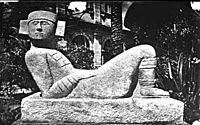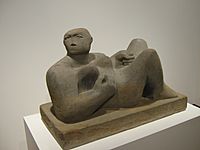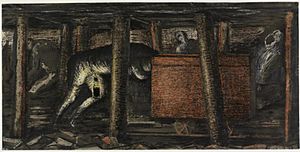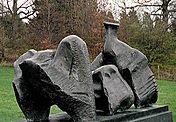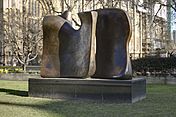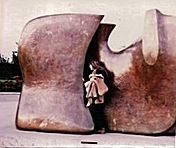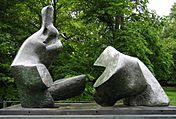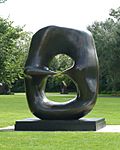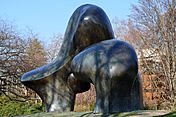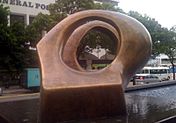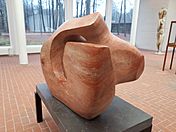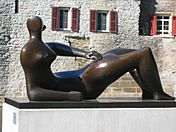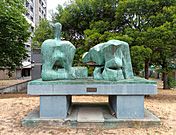Henry Moore facts for kids
Quick facts for kids
Henry Moore
|
|
|---|---|
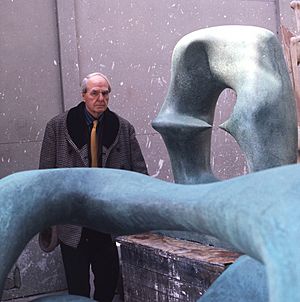
Moore in 1975
|
|
| Born |
Henry Spencer Moore
30 July 1898 Castleford, West Riding of Yorkshire, England
|
| Died | 31 August 1986 (aged 88) Much Hadham, Hertfordshire, England
|
| Education | Leeds School of Art Royal College of Art |
| Known for | Sculpture, drawing, graphics, textiles |
|
Notable work
|
List of sculptures |
| Movement | Bronze Sculpture, Modernism |
Henry Spencer Moore (30 July 1898 – 31 August 1986) was an English artist. He is best known for his monumental bronze sculptures which are located around the world as public works of art. Moore also produced many drawings.
The world's largest collection of Moore's work is open to the public and is housed in the house and grounds of the 70-acre estate that was Moore's home for 40 years in Perry Green in Hertfordshire.
Although his art earned him a lot of money, Moore lived frugally. Most of the money he made went towards the Henry Moore Foundation, which continues to support education and promotion of the arts.
Contents
Early life
Moore was born in Castleford, West Riding of Yorkshire, England, to Mary (née Baker) and Raymond Spencer Moore. He was the seventh of eight children. His family was extremely poor. He attended infant and elementary schools in Castleford, where he began modelling in clay and carving in wood.
He was accepted at Castleford Secondary School, where his headmaster soon noticed his talent and interest in medieval sculpture. Moore's earliest recorded carvings – a plaque for the Scott Society at Castleford Secondary School, and a Roll of Honour commemorating the boys who went to fight in the First World War from the school – were executed around this time.
At eighteen, Moore volunteered for army service in the First World War. He was the youngest man in the Prince of Wales' Own Civil Service Rifles regiment and was injured in 1917 in a gas attack, on 30 November at Bourlon Wood, during the Battle of Cambrai. After recovering in hospital, he saw out the remainder of the war as a physical training instructor, only returning to France as the Armistice was signed.
Beginnings as a sculptor
After the war, Moore became a student at the Leeds School of Art (now Leeds Arts University). In 1921, Moore won a scholarship to study at the Royal College of Art in London. While in London, Moore extended his knowledge of primitive art and sculpture, studying the ethnographic collections at the British Museum.
In 1924, Moore won a six-month travelling scholarship which he spent in Northern Italy studying the great works of Michelangelo, Giotto di Bondone, Giovanni Pisano and several other Old Masters. During this period he also visited Paris, took advantage of the timed-sketching classes at the Académie Colarossi, and viewed, in the Trocadero, a plaster cast of a Toltec-Maya sculptural form, the Chac Mool, which he had previously seen in book illustrations. The reclining figure was to have a profound effect upon Moore's work, becoming the primary motif of his sculpture.
Hampstead
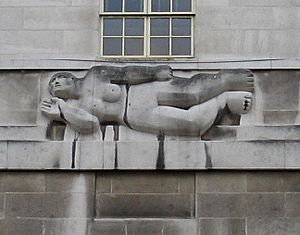
On returning to London, Moore undertook a seven-year teaching post at the Royal College of Art. His first public commission, West Wind (1928–29), was one of the eight reliefs of the 'four winds' high on the walls of London Underground's headquarters at 55 Broadway. The other 'winds' were carved by contemporary sculptors including Eric Gill with the ground-level pieces provided by Epstein. 1928 saw Moore's first solo exhibition, held at the Warren Gallery in London.
In 1929, Moore and his wife, Irina, moved to a studio in Hampstead at 11a Parkhill Road NW3.
In 1932, after six-year's teaching at the Royal College, Moore took up a post as the Head of the Department of Sculpture at the Chelsea School of Art.
Second World War
At the outbreak of the Second World War the Chelsea School of Art was evacuated to Northampton and Moore resigned his teaching post. During the war, Moore produced powerful drawings of Londoners sleeping in the London Underground while sheltering from the Blitz.
In August 1941 the War Artists' Advisory Committee (WAAC) commissioned Moore to draw miners working underground at the Wheldale Colliery in Yorkshire, where his father had worked at the start of the century. Moore drew the people in the shelters as passively waiting the all-clear while miners aggressively worked the coal-faces. Moore's drawings helped to boost his international reputation.
After their Hampstead home was hit by bomb shrapnel in September 1940, Moore and Irina moved out of London to live in a farmhouse called Hoglands in the hamlet of Perry Green near Much Hadham, Hertfordshire. This was to become Moore's home and workshop for the rest of his life. In 1943 he received a commission from St Matthew's Church, Northampton, to carve a Madonna and Child; this sculpture was the first in an important series of family-group sculptures.
Later years

.
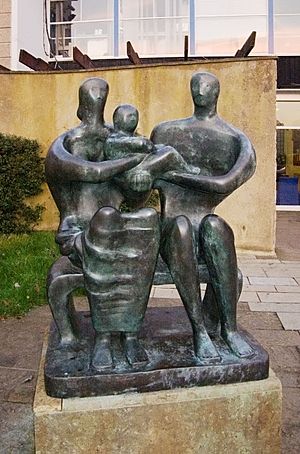
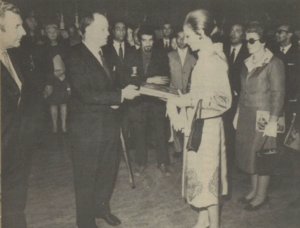
After the war, Moore produced many "mother-and-child" compositions, although reclining and internal/external figures also remained popular. He made his first visit to America when an exhibition of his work opened at the Museum of Modern Art in New York City.
In the 1950s, Moore began to receive increasingly significant commissions. He exhibited Reclining Figure: Festival at the Festival of Britain in 1951, and in 1958 produced a large marble reclining figure for the UNESCO building in Paris. With many more public works of art, the scale of Moore's sculptures grew significantly and he started to employ an increasing number of assistants to work with him.
Moore's Nuclear Energy was unveiled on the campus of the University of Chicago in December 1967, 25 years after the team of physicists led by Enrico Fermi achieved the first controlled, self-sustaining nuclear chain reaction. The 12-foot-tall piece in the middle of a large, open plaza is often thought to represent a mushroom cloud topped by a massive human skull, but Moore's interpretation was very different. He once told a friend that he hoped viewers would "go around it, looking out through the open spaces, and that they may have a feeling of being in a cathedral." Moore also produced a large bronze sundial for Chicago, Illinois, locally named Man Enters the Cosmos (1980), which was commissioned to recognise the space exploration program.
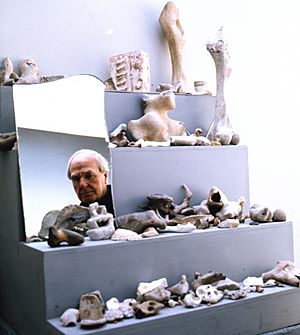
The last three decades of Moore's life the number of commissions continued to increase. He completed Knife Edge Two Piece in 1962 for College Green near the Houses of Parliament in London. By the end of the 1970s, there were some 40 exhibitions a year featuring his work.
Death
Moore died on 31 August 1986 at his home in Perry Green. His body was interred at the churchyard of St Thomas's Church.
Personal life
On 19 July 1929, Moore married Irina Radetsky, a painting student at the Royal College. Irina was born in Kyiv in 1907. Her father was killed in the Russian Revolution and her mother was evacuated to Paris where she married a British army officer. Irina was smuggled to Paris a year later and went to school there until she was 16, after which she was sent to live with her stepfather's relatives in Buckinghamshire.
Irina gave birth to their daughter, Mary Moore, in March 1946. The child was named after Moore's mother, who had died two years earlier.
Style
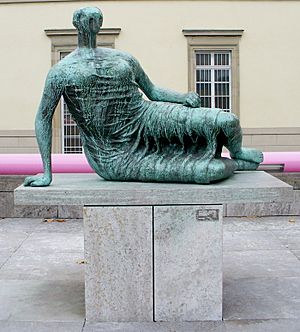
Moore's early work is focused on direct carving, in which the form of the sculpture evolves as the artist repeatedly whittles away at the block.
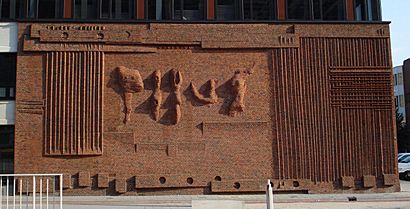

After the Second World War, Moore's bronzes took on their larger scale. He largely abandoned direct carving, and took on several assistants to help produce the larger forms based on maquettes. By the end of the 1940s, he produced sculptures increasingly by modelling, working out the shape in clay or plaster before casting the final work in bronze using the lost wax technique.
At his home in Much Hadham, Moore built up a collection of natural objects; skulls, driftwood, pebbles, rocks and shells, which he would use to provide inspiration for organic forms. For his largest works, he usually produced a half-scale, working model before scaling up for the final moulding and casting at a bronze foundry. Moore often refined the final full plaster shape and added surface marks before casting.
Legacy
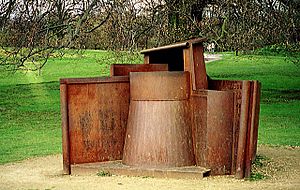
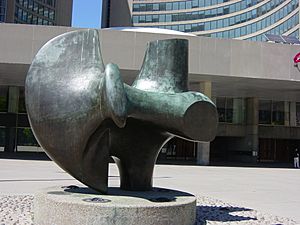
By the late 1940s, Moore was a worldwide celebrity. He had a direct influence on several generations of sculptors of both British and international reputation. Among the artists who have acknowledged Moore's importance to their work are Sir Anthony Caro, Phillip King and Isaac Witkin. Other artists whose work was influenced by him include Helaine Blumenfeld, Drago Marin Cherina, Lynn Chadwick, Eduardo Paolozzi, Bernard Meadows, Reg Butler, William Turnbull, Robert Adams, Kenneth Armitage, and Geoffrey Clarke.
Recognition
In 1948, Moore won the International Sculpture Prize at the Venice Biennale. He was awarded the Companion of Honour in 1955, the Order of Merit in 1963 and Erasmus Prize in 1968. He was also a member of both the American Academy of Arts and Sciences and the American Philosophical Society.
He was a trustee of both the National Gallery and Tate Gallery. In 1975, he became the first President of the Turner Society.
Art market
In 1982, four years before his death, Sotheby's in New York sold a 6 ft Reclining Figure (1945), for $1.2 million to collector Wendell Cherry. In 2012, his eight-foot bronze, Reclining Figure: Festival (1951) sold for a record £19.1 million at Christie's, making him the second most expensive 20th-century British artist after Francis Bacon.
Interesting facts about Henry Moore
- Moore decided to become a sculptor when he was eleven after hearing of Michelangelo's achievements at a Sunday School reading.
- Moore's parents had been against him training as a sculptor, a vocation they considered manual labour with few career prospects.
- Alice Gostick, Moore's art teacher at Castleford Secondary School, motivated him to make art his career.
- Moore made many preparatory sketches and drawings for each sculpture. He placed great importance on drawing. Most of these sketchbooks have survived.
- By the end of his career, Moore was the world's most successful living artist at auction.
- In 1951, Moore turned down a knighthood because he thought that such a title might cut him off from fellow artists.
- Henry Moore Foundation was established by Henry and his family in 1977 in England to support sculptors and develop appreciation for visual arts. The Foundation is still working.
- The Henry Moore Sculpture Centre in the Art Gallery of Ontario, Toronto, opened in 1974. It comprises the world's largest public collection of Moore's work, most of it donated by him between 1971 and 1974.
- Moore's Knife Edge Two Piece 1962–65 is displayed in Abingdon Street Gardens, opposite the Houses of Parliament, where its regular appearance in the background of televised news reports from Westminster makes it Moore's most prominent piece in Britain.
- Moore presented 36 sculptures, as well as drawings, maquettes and other works to the Tate Gallery in 1978.
- Moore's signature form is a reclining figure.
Henry Moore quotes
- "Art is the expression of imagination, not the reproduction of reality."
- "To be an artist is to believe in life."
- "The soul cannot thrive in the absence of art."
- "I think in terms of the day's resolutions, not the years'."
- "One never knows what each day is going to bring. The important thing is to be open and ready for it."
Gallery
-
Draped Seated Woman (1957–58), Hebrew University of Jerusalem
-
Three Piece Reclining Figure No.1 (1961), Yorkshire Sculpture Park
-
Knife Edge Two Piece (1962–65) (bronze), (1962), opposite House of Lords, London
-
Knife Edge Two Piece (1962–65), Queen Elizabeth Park, Vancouver, B.C., Canada. 1970.
-
Two Piece Reclining Figure No. 5 (1963–64), bronze, Kenwood House grounds, London
-
Oval with Points (1968–70), Henry Moore Foundation
-
Sheep Piece (1971–72), Zürichhorn, Zürich-Seefeld, Switzerland
-
Large Two Forms (1969), Art Gallery of Ontario
See also
 In Spanish: Henry Moore para niños
In Spanish: Henry Moore para niños
- List of sculptures by Henry Moore


